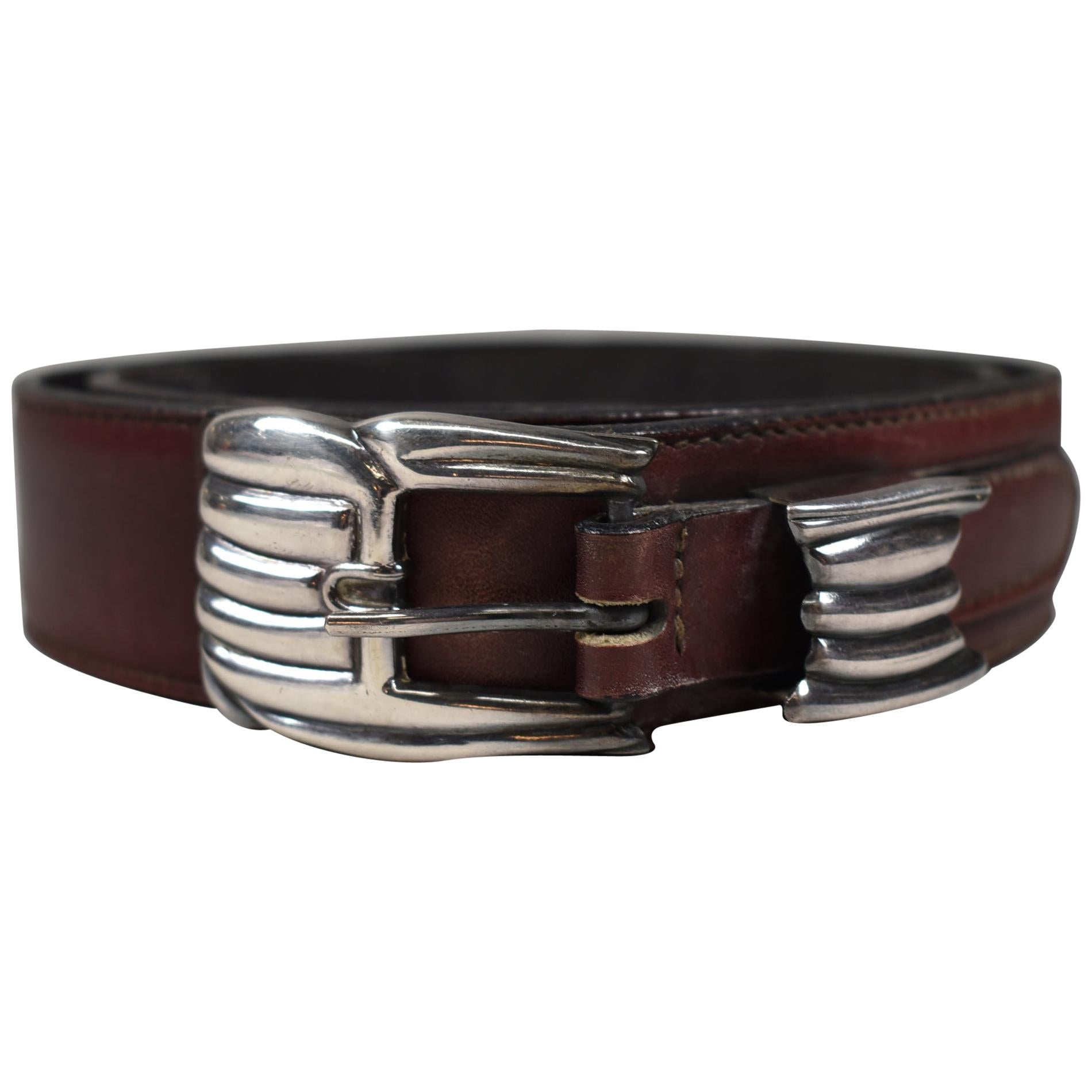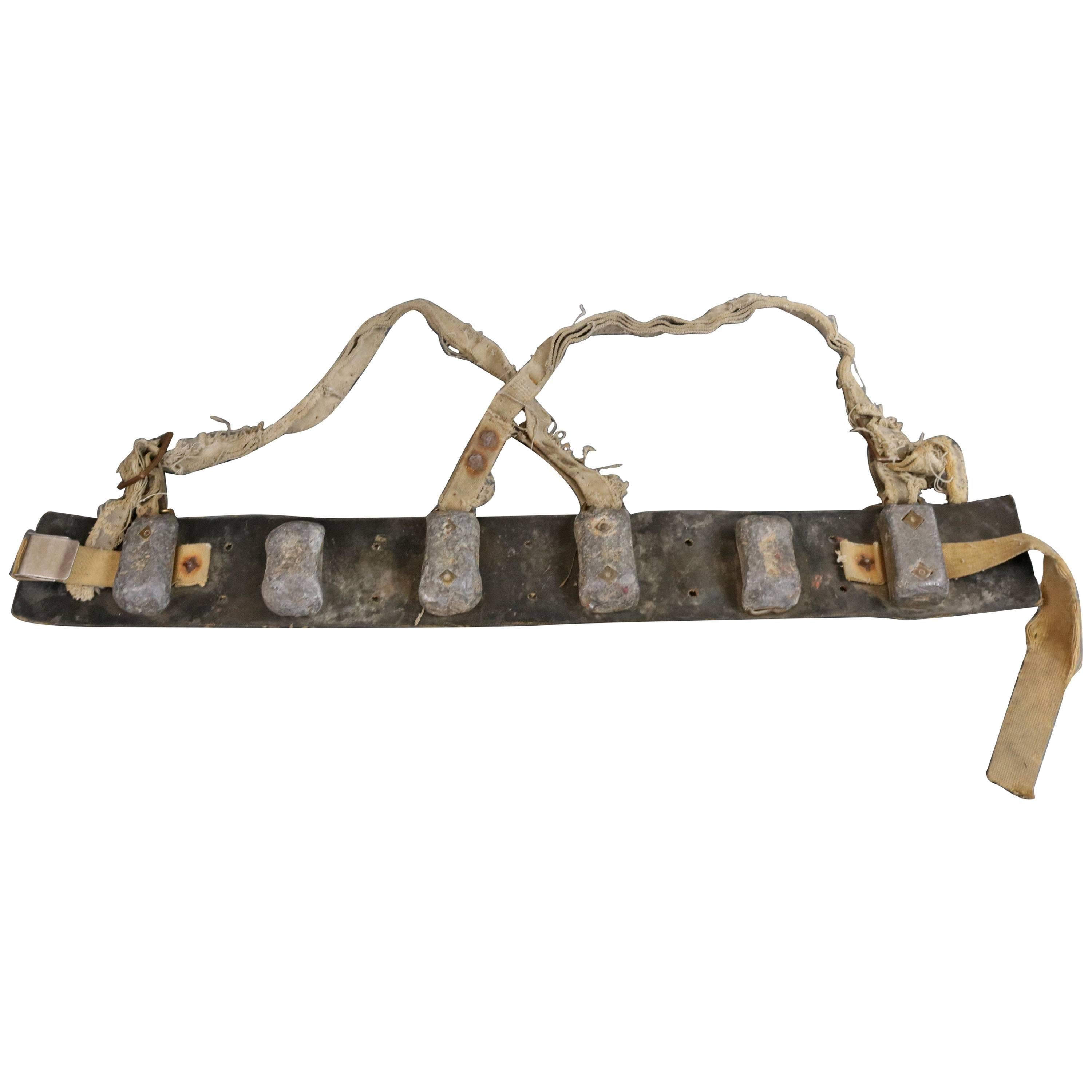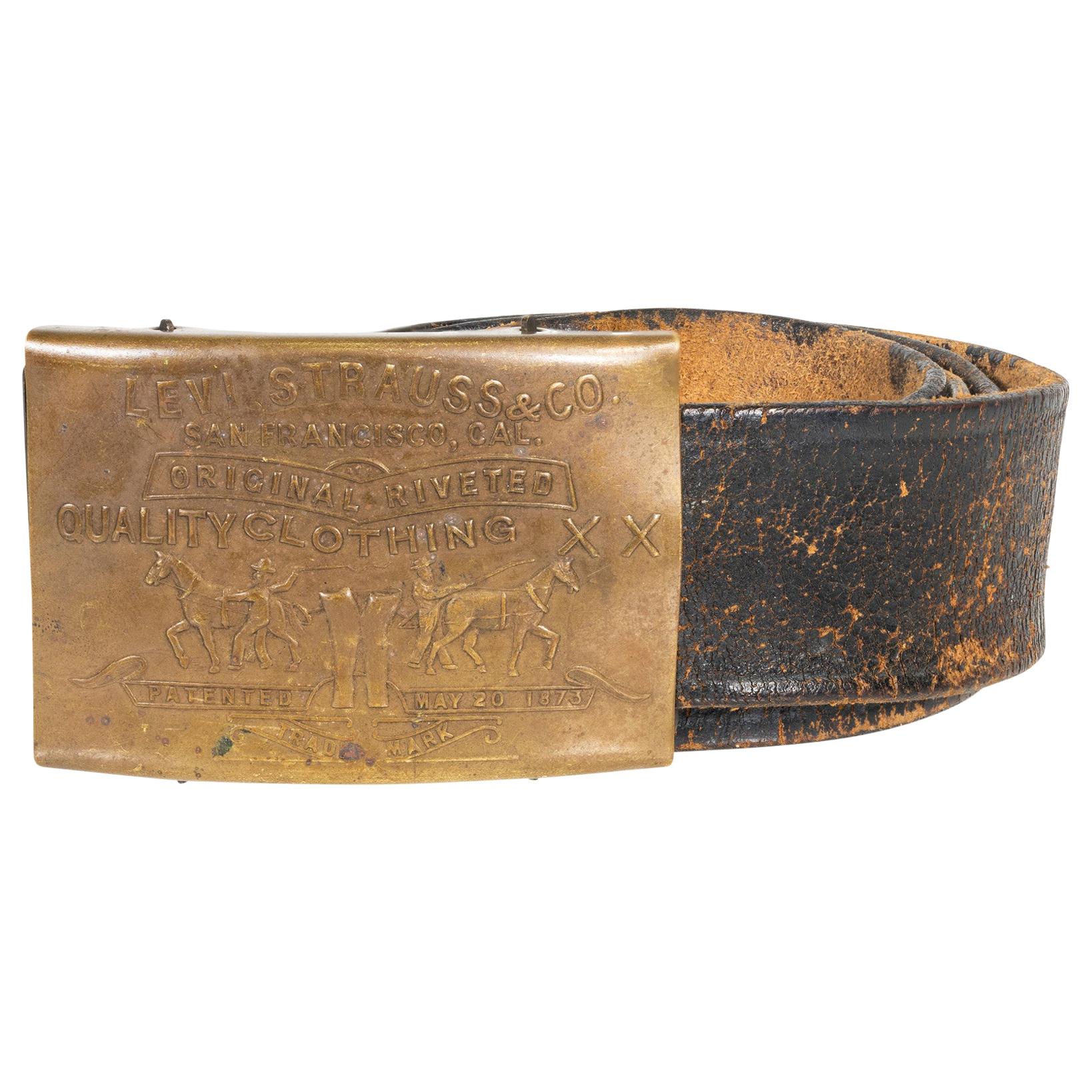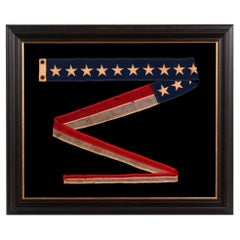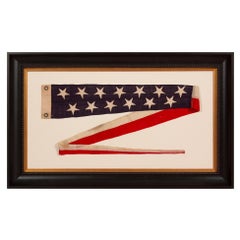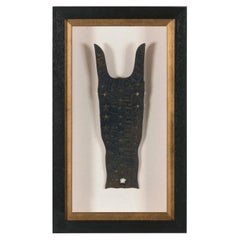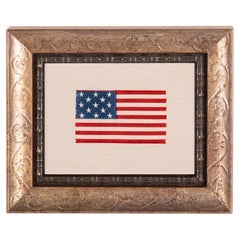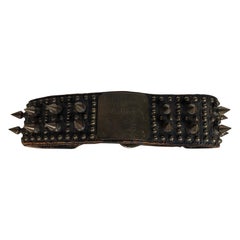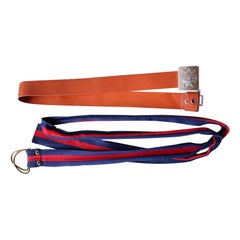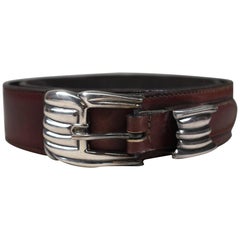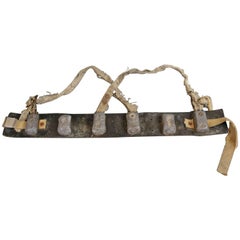Items Similar to Leather Fireman's Parade Belt
Want more images or videos?
Request additional images or videos from the seller
1 of 6
Leather Fireman's Parade Belt
$4,800
£3,642.13
€4,164.45
CA$6,704.30
A$7,454.27
CHF 3,892.21
MX$90,736.59
NOK 49,662.87
SEK 46,531.74
DKK 31,080.05
Shipping
Retrieving quote...The 1stDibs Promise:
Authenticity Guarantee,
Money-Back Guarantee,
24-Hour Cancellation
About the Item
Leather fireman's parade belt with the word "LIBERTY in white on a red ground, Bloomsburg, Pennsylvania, circa 1900
This fireman's parade belt is of the type produced during the latter part of the 19th century, between roughly 1870 and 1900. Made of leather, the body of the belt is black. In the center is a recessed window, with a fancifully scalloped edge, behind which a red leather panel, upon which the word "Liberty" appears in raised, white letters. There is a white binding, it's edge trimmed with pinking shears to create a decorative border. The metal buckle fits into an opposing leather strap, small in scale and riveted beneath the outer one.
The words that appear on fireman's parade belts were customized, sometimes displaying the title of the wearer (i.e., "chief" or "clerk"), sometimes the name of the city or town, and sometimes the name of the station, as-is the case in this instance.
Attributed to Bloomsburg, Pennsylvania (Columbia County), I acquired it about 25 miles southwest, in adjacent Union County. Bloomsburg's first fire house, Friendship Fire Company, was established in 1868, shortly following the Civil War. Like most volunteer departments of that time, it was staffed by returning Union soldiers who volunteered, enjoying the comradery. Three more would follow, including Rescue Hose & Ladder (1870), Winona (1881), and Liberty Fire Company (1900). In the early 1990's the process was begun to modernize and consolidate all four stations into one. Liberty's fire house still stands on the 100 block of Leonard Street.
Probably made in the year the Liberty Fire Company was established, for related parades and festivities, the great thing about this belt is the combination of the wonderful, early, painted surface and the terrific verbiage. While words such as "Clerk," "Bloomsburg," or "Rescue" would have limited appeal, the word "Liberty" opens the playing field to a nation-wide audience. Fire memorabilia is fervently collected, but it is also widely adored by Americana collectors in general. When you find objects that span categories like this, marketability grows. By opening then open another category into the world of paint-decorated American Folk Art, and then overlapping into that of patriotic objects, desirability intensifies.
Despite the popularity of the word "Liberty" as a name for a fire station in the 19th century, this is the only parade belt I have personally seen that features it.
In the year that the new fire station was dedicated, a parade was held. As it passed by each historic fire house, the procession halted and taps was played as the American flag was lowered for the final time.
Mounting: The belt has been handstitched to a background of 100% hemp fabric or a hemp and cotton blend (we use both interchangeably). It was then placed in a two-part frame that consists of a scooped molding with a surface that is very dark brown in color, almost black, with red undertones and highlights, to which a CAP was added with a finish that is constructed of wood, but has a finish that presents like antique iron. Spacers keep the object away from the glazing, which is U.V. protective plexiglass.
Condition: The leather tab that holds the buckle to the belt appears to have been replaced. Three of the rivets were replaced by a former owner. There is minor loss along the white border, minor soiling and paint loss.
Measurements:
Frame 11.75" x 50.25"
Belt 2.5" x 41".
- Dimensions:Height: 11.75 in (29.85 cm)Width: 50.25 in (127.64 cm)Depth: 2.5 in (6.35 cm)
- Materials and Techniques:
- Place of Origin:
- Period:1900-1909
- Date of Manufacture:1900
- Condition:See Item Description.
- Seller Location:York County, PA
- Reference Number:Seller: pat-6041stDibs: LU849718224721
About the Seller
5.0
Recognized Seller
These prestigious sellers are industry leaders and represent the highest echelon for item quality and design.
Established in 1991
1stDibs seller since 2008
70 sales on 1stDibs
Typical response time: 1 to 2 days
- ShippingRetrieving quote...Shipping from: York County, PA
- Return Policy
Authenticity Guarantee
In the unlikely event there’s an issue with an item’s authenticity, contact us within 1 year for a full refund. DetailsMoney-Back Guarantee
If your item is not as described, is damaged in transit, or does not arrive, contact us within 7 days for a full refund. Details24-Hour Cancellation
You have a 24-hour grace period in which to reconsider your purchase, with no questions asked.Vetted Professional Sellers
Our world-class sellers must adhere to strict standards for service and quality, maintaining the integrity of our listings.Price-Match Guarantee
If you find that a seller listed the same item for a lower price elsewhere, we’ll match it.Trusted Global Delivery
Our best-in-class carrier network provides specialized shipping options worldwide, including custom delivery.More From This Seller
View AllCommission Pennant with 13 Stars, like for Private Vessel, Ca 1892-1910
Located in York County, PA
Commission pennants are the distinguishing mark of a commissioned U.S. Navy ship. Flown at the topmast, the typical American format is a long blue field, usually with a single row of white stars, although sometimes with their total divided into two rows, followed by two long stripes, red-over-white. A ship became commissioned when this pennant was hoisted. Flown during both times of peace and war, the only time the pennant is not flown is if a flag officer or civilian official was aboard and replaced it with their own flag.
Sometimes the owners of private ships mimicked the use of Navy signals. Some seafaring men would have served in the Navy and become privy to various practices in that capacity. Others flew them purely for stylistic reasons, either on a regular basis or while the boat was dressed for special occasion. Hudson River steamers regularly flew pennants of this nature, as evidenced by period photography as well as the paintings of artists such as John and James Bard...
Category
Antique Late 19th Century American Political and Patriotic Memorabilia
Materials
Wool
Price Upon Request
13 Star Commission Pennant, 6 Foot in Length, ca 1892-1910
Located in York County, PA
6-FOOT SHIP’S COMMISSION PENNANT WITH A 5.5” HOIST AND 13 STARS IN 2 STAGGERED ROWS, LIKELY PRODUCED FOR A PRIVATE VESSEL, circa 1892-1910
Commission pennants are the distinguishing...
Category
Antique 1890s American Political and Patriotic Memorabilia
Materials
Wool
Cast Iron Boot Jack Made for 1864 Presidential Campaign of George McClellan
Located in York County, PA
CAST IRON BOOT JACK, MADE FOR THE 1864 PRESIDENTIAL CAMPAIGN OF GENERAL GEORGE B. MC CLELLAN, WITH A FANTASTIC SLOGAN THAT READS "THE UNION AT ALL HAZZARDS"
Made for the 1864 presidential run of George B. McClellan, this cast iron bootjack is both rare and graphically exceptional. Displaying the original black-painted surface, with attractive and desirable patina, the stylized profile has a wonderful folk art quality. Molded block letters that wrap around the heel clasp read simply "Gen. Mc Clellan. These are accompanied by a prominent Civil War-associated slogan: "The Union at all Hazards." The text is intermingled with 34 stars, which was equivalent to the number of states during the opening two years of the war, but was one star short by mid-1863 and two stars short by the time of the actual election in 1864. It's not unusual to encounter this feature in civil war campaign parade flags as well as all manner of flag-related ephemera.
The iron was reportedly cast by G. & D. Cross of Morrisville, New York, though it is unsigned and I have not yet verified the attribution. I have seen two other examples, one of which had a broken and repaired tine on the U-shaped horns and newly painted surface, while the other appeared to have broken lifters and inferior, rusted patina. This is, hands-down, the best of the identified examples.
Brief History of the 1864 Campaign:
President Abraham Lincoln had a checkered relationship with his 1864 opponent, who he had formerly chosen as General-in-Chief of the entire Union Army. The career officer repeatedly knocked heads with his Commander-in-Chief. Having raised a well-trained and organized military force, McClellan often seemed reluctant to use it. By 1862, after losses in Virginia during the Peninsula Campaign, Lincoln grew frustrated with McClellan and the progression of the war and removed him from command.
By the early part of 1864 the American people shared some of the same frustrations and Lincoln was no longer the clear choice for the White House. The nation was tired of war and the remains of the Democratic Party...
Category
Antique 1860s American Political and Patriotic Memorabilia
Materials
Iron
13 Star Woven Silk Ribbon, ca 1876-1910
Located in York County, PA
13 STAR RIBBON, WOVEN SILK, circa 1876-1910
13 star antique American flag ribbon, made of woven silk, of the type encountered in military, political, and fraternal badges and ribbon...
Category
Antique 1870s American Political and Patriotic Memorabilia
Materials
Silk
34 STAR AMERICAN FLAG, CIVIL WAR, 1861-63, KANSAS STATEHOOD, 2nd KY CAVALRY
Located in York County, PA
34 STAR ANTIQUE AMERICAN FLAG OF THE CIVIL WAR PERIOD (1861-63), IN A TINY SCALE AMONG PIECED-AND-SEWN FLAGS OF THE PERIOD, WITH A TRIPLE-WREATH CONFIGURATION, AN ELONGATED FORMAT, AND ENTIRELY HAND-SEWN; FOUND WITH A LETTER FROM JOHN W. RUDE OF THE 2ND KENTUCKY VETERAN VOLUNTEER CAVALRY (UNION):
34 star flag of the Civil War period with a variety of extremely desirable features, handed down with a letter written by John W. Rude on November 8th, 1864, while encamped with the Army’s 1st Brigade, 3rd Division, as a member of the 2nd Regiment of Veteran Volunteer Cavalry. Tiny in scale among pieced and sewn examples, the flag displays a star pattern that consists of a three consecutive wreaths, with a single star in the very center. Because it lacks a single star in each corner, outside the basic pattern—usually present in flags of this design made during the mid-late 19th century—this is something I classify as a “snowball medallion.” Entirely hand-sewn throughout, note the square format of the blue canton, with its beautiful, circular star arrangement, and how interesting this combination is when paired with the elongated format of the flag itself. The stars are double-appliqued, meaning that they are applied to both sides. These are fat in shape and inconsistent in size. Note how the lowest star in the outermost ring actually dips into the white stripe below.
Made of plain weave cotton, there is a narrow binding along the hoist, red in color, with three sets of cotton ties. Those at the top and bottom are made of fine, braided hemp or hemp and cotton cord, stitched into place, while the one in the center, looped around the binding and tied, is made of lightweight, twisted, cotton thread. Note how the 5th, 6th, and 7th red stripes are pieced from two lengths of cotton fabric, which reflects that the maker was being conscious of conserving available fabric.
In the 19th century, most flags with pieced and sewn construction were 8 feet long and larger. A six-footer was considered small. Even military battle flags, carried on foot, measured 6’ x 6.5’, which translates into approximately 7’ x 7.5’ after framing, about the size of an average quilt and larger than can comfortably fit on a wall in a house with 8-foot ceilings and average width baseboard. Flags smaller than this exist, but the smaller they get, the more unusual they are. At just 1.5’ x 3’, this is about as small as one will ever encounter in a sewn flag of the Civil War era.
The flag appears to have likely been hand-carried. I expect that it probably saw military use of some sort as a camp flag...
Category
Antique 1860s American Political and Patriotic Memorabilia
Materials
Cotton
Pressed Brass Eagle, Parade Flag Holder and Bunting Tie Back, ca 1880-1895
Located in York County, PA
Pressed brass eagle, an early parade flag holder & bunting tie-back, an especially attractive example, circa 1880-1895
Pressed brass eagles decorated the interiors of Civil War ve...
Category
Antique Late 19th Century American Political and Patriotic Memorabilia
Materials
Brass
You May Also Like
19th Century Studded Leather Dog Collar
Located in Riverdale, NY
19th Century Studded Leather Dog Collar, of UK or USA origin. Heavy leather with studs and spikes bolted throughout. Name plate is marked "Battling Mike, H.A.S.". Late 19th Century. ...
Category
Antique 1880s American Late Victorian Figurative Sculptures
Materials
Brass
Set of 2 Vintage Belts from USSR: Timeless Elegance in Brown and Navy Blue, 1J98
Located in Bordeaux, FR
Step into the world of vintage elegance with this exquisite set of 2 belts from the USSR, crafted with distinctive styles that reflect the fashion essence of the 1970s. Each belt carries its unique charm and allure, adding a touch of retro allure to your wardrobe.
The first belt, in a classic brown color, is designed for a child and made from faux leather. Adorned with a buckle featuring the image of the star, the iconic symbol of the USSR, this belt exudes a sense of historical significance. Measuring approximately 55cm in length and 2.5cm in width, this belt offers a perfect fit for a child's waist, combining style with practicality. In original good condition, the brown belt has been preserved impeccably, showcasing its enduring quality.
The second belt, in navy blue and red shades and crafted from fabric, adds a pop of color to your outfit. With its longer length, measuring around 119cm, and a width of 3cm, this belt offers versatility in styling, allowing you to experiment with various waist cinching techniques. Despite some signs of age, this belt still retains its charm and uniqueness, making it a distinctive accessory that embraces the nostalgia of the era.
Perfect for collectors of vintage fashion, lovers of classic elegance, or anyone seeking unique accessories, this set of 2 belts from the 1970s USSR is a delightful find. Embrace the opportunity to own a piece of history, and let the brown and navy blue belts make a bold fashion statement.
Add this set of vintage belts to your collection and let their timeless elegance elevate your style. Celebrate the allure of authentic vintage fashion...
Category
Vintage 1970s Antiquities
Materials
Leather, Fabric
C G Italian Leather Belt with Sterling Silver Buckle
Located in Toledo, OH
C G Italian leather belt with sterling silver buckle, end tip and belt loop. Size: 28. Very good condition. Dimensions: .25" depth x 35" W x 1.5" tall.
Category
20th Century European Modern Sterling Silver
Materials
Sterling Silver
Homemade Deep Sea Diver's Belt
Located in Norwell, MA
Homemade weights, canvas straps, rubber belt and brass buckle. Dimensions: 48" L.
Category
20th Century Nautical Objects
Early 20th Century English 6-Brass Leather Horse Strap
Located in Chapel Hill, NC
Early 20th century English 6-brass leather horse strap. Thick, shaped black leather. Brasses of a bull, plowman, oak leaves & acorn, horse's bust in bridle, wheat sheaf & tools, and ...
Category
Early 20th Century English Art Deco Decorative Art
Materials
Brass
1920s Rare Levi Strauss & Co. Belt Buckle
By STRAUSS
Located in Coeur d'Alene, ID
Brass belt buckle marked "San Francisco, CAL." Original riveted quality clothing. Patented May 20, 1873 trademark. With original black leather belt which has seen wear but complete. ...
Category
Vintage 1920s American Historical Memorabilia
Materials
Brass
More Ways To Browse
American Leather Company
19th Century Belter Furniture
Antique Leather Straps
Space Memorabilia
Antique Belts And Buckles
American Folk Art Wood House
Antique Hemp
Folk Art Soldier
Antique Union Cases
Antique Painted Leather Panels
Antique Black Americana Black Americana
Liberty Fabric
Antique Metal Soldiers
Leonards Antiques
American Flags And Americana
Antique Shears and Scissors
Civil War Memorabillia
Civil War Flags


